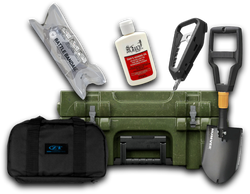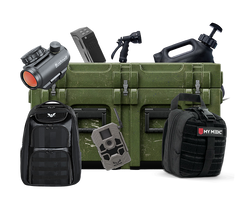Is a Carbine Considered a Rifle? Understanding the Differences and Definitions
Table of Contents
- Introduction
- Defining the Terms: What is a Rifle?
- What is a Carbine?
- The Relationship Between Carbines and Rifles
- Advantages of Carbines Over Traditional Rifles
- The Tactical Edge: Why Choose a Carbine?
- Conclusion
- Frequently Asked Questions
Introduction
When delving into the world of firearms, one of the most frequently asked questions is whether a carbine is considered a rifle. The answer to this seemingly simple question holds significant implications for gun enthusiasts, military personnel, and law enforcement agencies alike. Understanding the distinctions between these two types of firearms not only enhances one's knowledge but also informs decisions regarding purchasing, usage, and compliance with legal regulations.
Carbines and rifles share common characteristics, yet they have distinct features that set them apart. Historically, carbines were designed for specific purposes, particularly in cavalry and mobile warfare contexts, whereas rifles have evolved as versatile firearms for various applications. Today, as tactical gear and firearms technology continue to advance, the lines between these categories can sometimes blur, leading to confusion and misconceptions.
In this blog post, we will clarify the definitions of carbines and rifles, explore their historical contexts, and discuss the practical implications of understanding these differences. By the end, you will have a comprehensive understanding of whether a carbine is considered a rifle and how this classification affects your choices. We will also touch on how Crate Club's subscription services can enhance your tactical preparedness, ensuring you have the right gear for any situation.
Defining the Terms: What is a Rifle?
A rifle is defined as a firearm that is designed to be fired from the shoulder, featuring a rifled barrel that imparts spin to the projectile for improved accuracy. According to U.S. law, specifically the National Firearms Act (NFA), a rifle must have a barrel length of over 16 inches and an overall length of over 26 inches. The primary function of a rifle is to deliver accurate fire over long distances, making it suitable for hunting, sport shooting, and tactical applications.
Key Characteristics of a Rifle
- Rifled Barrel: The rifling inside the barrel causes the bullet to spin, stabilizing it in flight and increasing accuracy.
- Shoulder-Fired: Rifles are designed to be fired from the shoulder, providing better stability and control.
- Longer Barrel Length: Most rifles have barrels that exceed 16 inches, allowing for higher muzzle velocity and greater effective range.
- Versatility: Rifles can be used in various contexts, from hunting and sport shooting to military and law enforcement applications.
What is a Carbine?
A carbine is essentially a shortened version of a rifle. Traditionally, these firearms were designed for cavalry use, allowing mounted troops to have a more manageable weapon compared to full-length rifles. Modern carbines, however, have evolved to serve a wider range of purposes, including tactical and personal defense scenarios.
Key Characteristics of a Carbine
- Shorter Barrel: Carbines typically have barrel lengths under 20 inches, often around 16 to 18 inches, making them more compact and lighter than traditional rifles.
- Ease of Handling: The reduced size and weight of carbines make them easier to maneuver, particularly in close-quarter combat or when entering and exiting vehicles.
- Versatile Caliber Options: Carbines can be chambered for various cartridges, including rifle and pistol calibers, which can affect their effectiveness in different scenarios.
- Modern Usage: Today, carbines are favored by military and law enforcement personnel for their balance of portability and firepower.
The Relationship Between Carbines and Rifles
Now that we have defined both terms, we can address the primary question: Is a carbine considered a rifle? The answer is yes, a carbine is a type of rifle. However, it is essential to understand that not all rifles are carbines. Here’s how the two categories relate:
Legal Definitions
According to the NFA, the legal definition of a rifle encompasses any firearm designed to be fired from the shoulder with a rifled barrel. Since carbines meet this criterion, they are legally classified as rifles. The distinction often lies in their intended use, barrel length, and design characteristics.
Historical Context
Historically, the term "carbine" originated from the French word "carabine," referring to soldiers who used shorter firearms on horseback. As warfare evolved, carbines became essential for troops requiring lightweight weapons that were easier to handle in dynamic combat situations. This historical context informs current perceptions and classifications.
Advantages of Carbines Over Traditional Rifles
While carbines are technically classified as rifles, they offer unique advantages that can make them a preferred choice for many users. Let's explore some of these benefits:
1. Maneuverability
Carbines are lighter and shorter than full-sized rifles, making them easier to handle in tight spaces or during rapid movements. This quality is particularly beneficial in urban combat scenarios or when navigating through dense brush during hunting excursions.
2. Reduced Recoil
Due to their lighter construction and shorter barrel lengths, carbines often produce less recoil than traditional rifles. This feature enhances shooter's control, allowing for quicker follow-up shots and improved accuracy, especially for less experienced shooters.
3. Versatile Applications
Carbines can be chambered for various calibers, including pistol cartridges, which makes them suitable for a wide range of applications—from home defense to competitive shooting. This versatility allows users to select a carbine that aligns with their specific needs, whether for sport or tactical purposes.
4. Compatibility with Accessories
Many modern carbines are designed to be compatible with a variety of accessories, such as optics, lights, and grips. This adaptability allows users to customize their carbines for different missions and environments, enhancing their overall effectiveness.
The Tactical Edge: Why Choose a Carbine?
The tactical advantages of carbines make them increasingly popular among military and law enforcement agencies. Their compact design, combined with the ability to deliver effective firepower, positions carbines as ideal solutions for modern combat scenarios.
Examples of Modern Carbines
- M4 Carbine: The standard issue for the U.S. military, the M4 features a 14.5-inch barrel and is chambered for the 5.56mm NATO cartridge. Its lightweight design and modular capabilities make it a favorite among troops.
- Ruger PC Carbine: This versatile firearm can be chambered for various pistol cartridges and is designed to accept magazines from popular pistol brands. It’s favored for its ease of use and adaptability for personal defense.
- Kel-Tec SUB-2000: A unique folding carbine that accepts popular pistol magazines, the SUB-2000 offers portability without sacrificing performance, making it a great choice for concealed carry or truck carry.
How Crate Club Fits In
At Crate Club, we understand the importance of having reliable, high-quality gear for your tactical needs. Our subscription services offer curated selections of gear that can complement your carbine or rifle, ensuring you are well-prepared for any situation. With options ranging from survival tools to self-defense gear, our products help you enhance your readiness.
- Explore our subscription services: Crate Club Subscription Services
- Check out our gear: Crate Club Shop
Conclusion
In summary, a carbine is indeed considered a rifle, as it meets the legal definitions and shares fundamental characteristics with traditional rifles. However, its unique attributes—such as a shorter barrel and lighter weight—set it apart, making it a favored choice for many tactical applications.
As we have explored, the relationship between carbines and rifles is nuanced and deeply rooted in history, practicality, and evolving military needs. Whether you are a seasoned enthusiast or a newcomer to the world of firearms, understanding these distinctions equips you with the knowledge necessary to make informed decisions regarding your gear and usage.
Embrace the tactical advantage that comes with understanding your weapons and gear. Join the Crate Club community, and ensure you're always prepared with the best tactical gear available.
Frequently Asked Questions
Is the AR-15 a carbine?
The AR-15 is often classified as a carbine because it is a lightweight, shorter variant of the AR-10 rifle. However, the designation can vary based on barrel length and configuration.
Can a carbine be chambered for rifle cartridges?
Yes, many modern carbines are chambered for rifle cartridges, allowing them to offer significant firepower while maintaining a compact design.
Are there legal restrictions on carbines?
Yes, in the U.S., carbines with barrels shorter than 16 inches are classified as Short Barreled Rifles (SBR) and require registration with the ATF. Always ensure compliance with local laws when purchasing or modifying firearms.
What are some popular calibers for carbines?
Common calibers for carbines include .223 Remington, 5.56mm NATO, and various pistol calibers such as 9mm and .45 ACP, providing versatility for different shooting applications.
How can I ensure I have the right gear for my carbine?
Consider subscribing to Crate Club, where you can receive curated gear tailored to your tactical needs, ensuring that you are always equipped for any situation. Explore our offerings: Crate Club Subscription Services and Crate Club Shop.
Comparte este artículo



